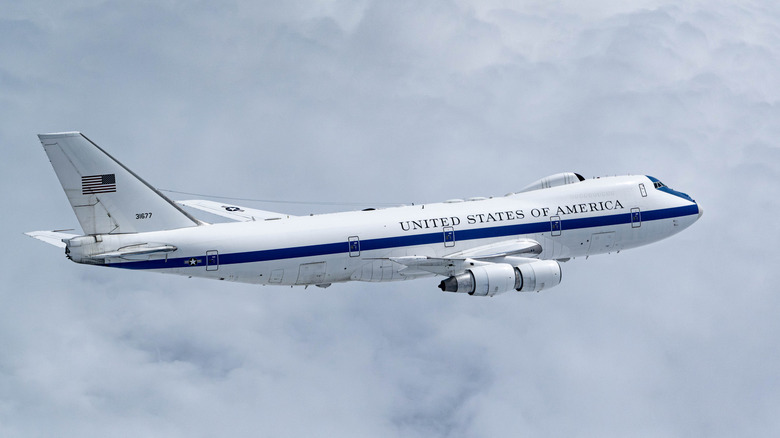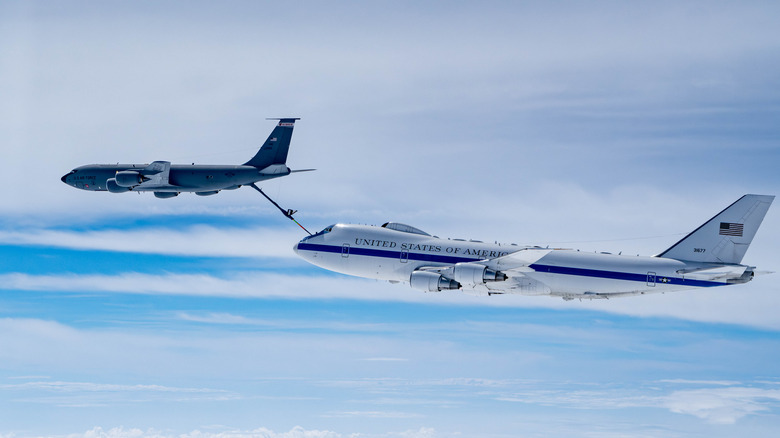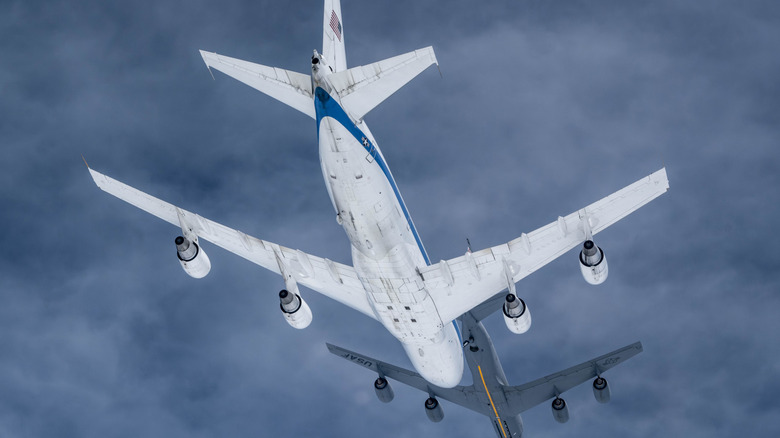How Long Can The E-4B Doomsday Plane Stay Airborne?
The U.S. Air Force E-4B Nightwatch is a modified Boeing 747-200, also called the Doomsday airplane. Built in the 1970s, the four E-4Bs were designed to act as a flying White House in case a nuclear war broke out. The aircraft was modified to be able to fly for 12 hours at a time without refueling. Based on data from Boeing, the standard 747-200 should be able to fly for approximately 14 hours. Given that the E-4B and 747-200 share the same fuel tank capacities and that they share the same General Electric CF6 turbofan engines, ordinarily, they should have roughly the same range, but they don't.
Though the E-4B shares engines and fuel systems with the 747-200, it is not identical. First of all, there is the matter of weight. The maximum takeoff weight of the E-4B is 800,000 lbs, while versions such as the -200SP had much lower limits to maximize range. Also, the load on the engines from the electronics systems is greater than on commercial aircraft, so the engines work harder. The extra weight affects the ceiling as well. The Air Force says the Nightwatch can fly to over 30,000 feet, while the 747-200 is rated to fly to up to 45,000 feet.
An ace in the E-4B's nose
When it comes to staying in the air, the E-4B has an advantage over commercial 747-200s because it is modified for aerial refueling. The aircraft has a refueling intake located between the cockpit's front windows and its nose, and a spoiler flap that lifts during refueling to diminish oscillations generated at the nose during refueling. The Nightwatch needs a lot of fuel to keep the four CF6s turning, and refilling its fuel tanks requires two full KC-135 tankers.
The E-4B has another refueling function that it shares with only a few other aircraft, including the VC-25 and tanker aircraft such as the KC-135 and KC-10A. The E-4B can also send back fuel to the tanker aircraft. With this function, the E-4B can act as a traveling gas can between tankers and help move jet fuel around the world to keep the fleet up in the air.
The E-4B can't fly forever
If an E-4B has a readily available source of jet fuel through in-air refueling, you might think that the aircraft could stay in the air indefinitely. However, the engines need fluids other than fuel to keep running. Like engines in cars, jet propulsion systems need oils and greases to keep all of the parts, such as bearings, appropriately lubricated. Otherwise, the engine might seize or overheat. One flight had an E-4B stay in the air for over 35 hours continuously, but planners envision the aircraft staying in the air from 72 hours up to a full week.
In the early 2020s, initial plans were drawn to replace the E-4B with the E-4C. The new aircraft is slated to be built from the basis of a 747-8i. However, there are currently no specifications posted for the unrefueled flight endurance of the new craft, nor any indication of in-air refueling capabilities, either.


